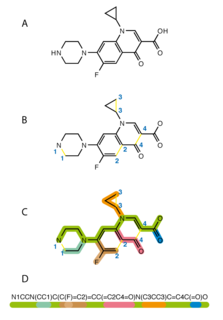
The International Standard Book Number (ISBN) is a numeric commercial book identifier which is intended to be unique. Publishers purchase ISBNs from an affiliate of the International ISBN Agency.

A numeral system is a writing system for expressing numbers; that is, a mathematical notation for representing numbers of a given set, using digits or other symbols in a consistent manner.

The simplified molecular-input line-entry system (SMILES) is a specification in form of a line notation for describing the structure of chemical species using short ASCII strings. SMILES strings can be imported by most molecule editors for conversion back into two-dimensional drawings or three-dimensional models of the molecules.
The reflected binary code (RBC), also known just as reflected binary (RB) or Gray code after Frank Gray, is an ordering of the binary numeral system such that two successive values differ in only one bit .
The reflected binary code was originally designed to prevent spurious output from electromechanical switches. Today, Gray codes are widely used to facilitate error correction in digital communications such as digital terrestrial television and some cable TV systems.

A postal code is a series of letters or digits or both, sometimes including spaces or punctuation, included in a postal address for the purpose of sorting mail.
In computer science, extended Backus-Naur form (EBNF) is a family of metasyntax notations, any of which can be used to express a context-free grammar. EBNF is used to make a formal description of a formal language such as a computer programming language. They are extensions of the basic Backus–Naur form (BNF) metasyntax notation.
The National Drug Code (NDC) is a unique product identifier used in the United States for drugs intended for human use. The Drug Listing Act of 1972 requires registered drug establishments to provide the Food and Drug Administration (FDA) with a current list of all drugs manufactured, prepared, propagated, compounded, or processed by it for commercial distribution. Drug products are identified and reported using the NDC.

An International Standard Serial Number (ISSN) is an eight-digit serial number used to uniquely identify a serial publication, such as a magazine. The ISSN is especially helpful in distinguishing between serials with the same title. ISSN are used in ordering, cataloging, interlibrary loans, and other practices in connection with serial literature.
HAVAL is a cryptographic hash function. Unlike MD5, but like most modern cryptographic hash functions, HAVAL can produce hashes of different lengths – 128 bits, 160 bits, 192 bits, 224 bits, and 256 bits. HAVAL also allows users to specify the number of rounds to be used to generate the hash. HAVAL was broken in 2004.
Vehicle registration plates of the Netherlands are vehicle registration plates issued by the Netherlands Vehicle Authority, RDW.
The Official Municipality Key, formerly also known as the Official Municipality Characteristic Number or Municipality Code Number, is a number sequence for the identification of politically independent municipalities or unincorporated areas. Other classifications for the identification of areas include postal codes, NUTS codes or FIPS codes.
A national identification number, national identity number, or national insurance number is used by the governments of many countries as a means of tracking their citizens, permanent residents, and temporary residents for the purposes of work, taxation, government benefits, health care, and other governmentally-related functions. The number appears on identity documents issued by several countries.

Bijective numeration is any numeral system in which every non-negative integer can be represented in exactly one way using a finite string of digits. The name derives from this bijection between the set of non-negative integers and the set of finite strings using a finite set of symbols.

The International Article Number is a standard describing a barcode symbology and numbering system used in global trade to identify a specific retail product type, in a specific packaging configuration, from a specific manufacturer. The standard has been subsumed in the Global Trade Item Number standard from the GS1 organization; the same numbers can be referred to as GTINs and can be encoded in other barcode symbologies defined by GS1. EAN barcodes are used worldwide for lookup at retail point of sale, but can also be used as numbers for other purposes such as wholesale ordering or accounting.

Tail codes are the markings usually on the vertical stabilizer of U.S. military aircraft that help to identify the aircraft's unit and/or base assignment and occasionally other information that is not unique. This is not the same as the serial number, bureau number, or aircraft registration which provide unique aircraft identification.

The Identity card is the document issued to every Romanian citizen at 14 years of age. The only exemption are Romanian citizens domiciled abroad. If they establish a temporary residence in Romania, then they may apply for a "Carte de identitate provizorie", which is valid for one year (renewable).
The national conventions for writing telephone numbers vary by country. While international standards exist in the form of the International Telecommunication Union sector ITU-T issued recommendation E.123, national telephone numbering plans define the format and length of telephone numbers assigned to telephones.
SWIFT Message types are the format or schema used to send messages to financial institutions on the SWIFT network. The original message types were developed by SWIFT and retrospectively made into an ISO standard, ISO 15022. This was later supplemented by a XML based version under ISO 20022.
A forecast region is a unique geographical area for which individual weather reports are issued.
The Unicode Standard assigns character properties to each code point. These properties can be used to handle "characters" in processes, like in line-breaking, script direction right-to-left or applying controls. Slightly inconsequently, some "character properties" are also defined for code points that have no character assigned, and code points that are labeled like "<not a character>". The character properties are described in Standard Annex #44.







